TMA01: Digital Divide and Inequality in Nigeria - A Study
VerifiedAdded on 2022/08/12
|5
|1302
|27
Report
AI Summary
This report, submitted as TMA01, investigates the digital divide and inequality in Nigeria, focusing on the disparities in Information and Communication Technology (ICT) access and ownership. The study aims to explore the existing situation, investigate the underlying causes, and examine strategies to reduce the digital divide, particularly in rural areas. The methodology involves a secondary review of government documents, published reports, and previous research papers. The report addresses the lack of fixed internet broadband and wireless connectivity, referencing the Internet of Things (IoT) and its benefits, as well as the challenges of digital inequity. The life cycle model includes project aim identification, data collection and review, and final documentation. The report highlights the importance of addressing infrastructural barriers, low income, and educational limitations to bridge the digital gap and provide recommendations for Nigeria to reduce the digital device. The author has selected several articles for the literature review and reflection to support the research.
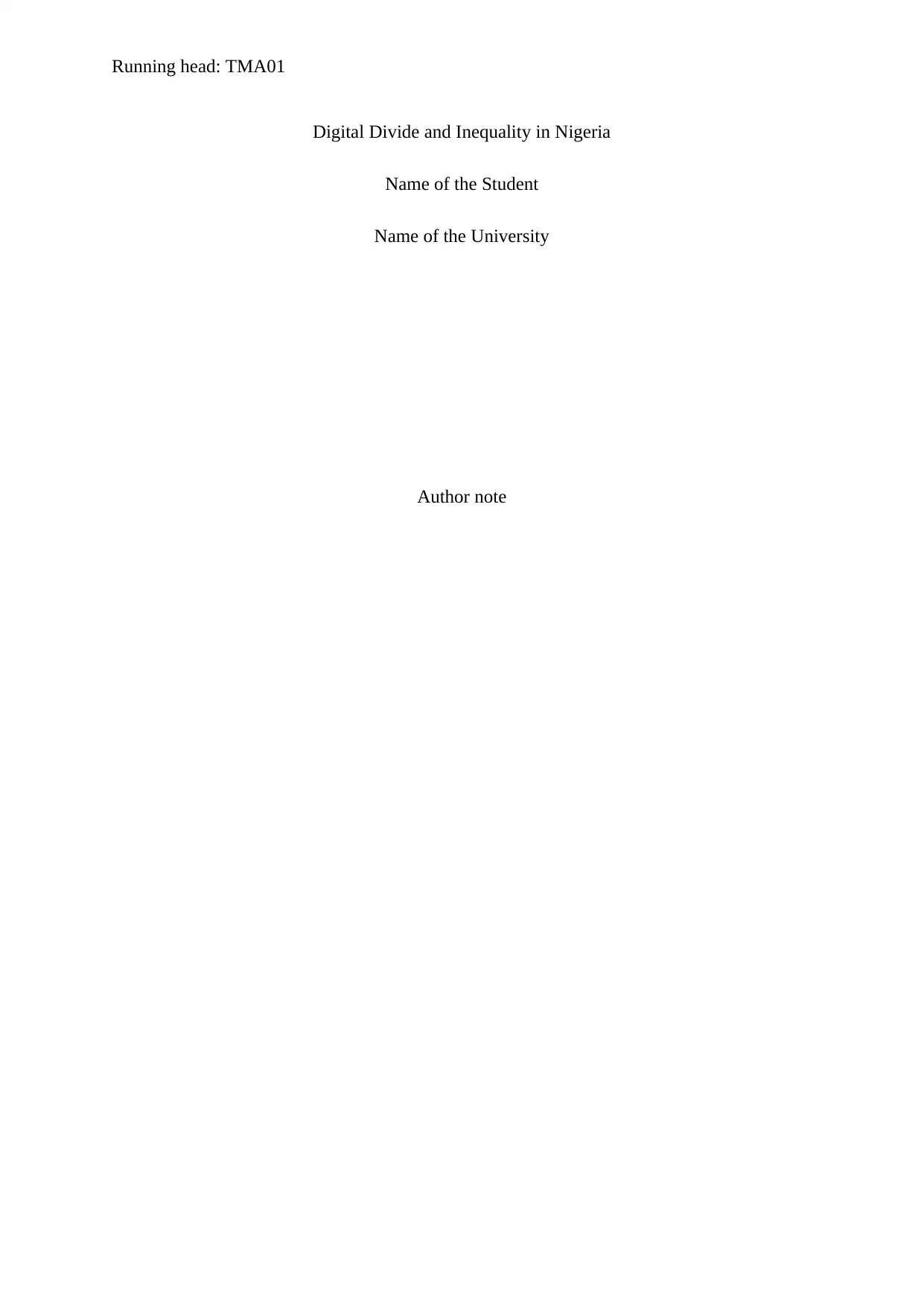
Running head: TMA01
Digital Divide and Inequality in Nigeria
Name of the Student
Name of the University
Author note
Digital Divide and Inequality in Nigeria
Name of the Student
Name of the University
Author note
Paraphrase This Document
Need a fresh take? Get an instant paraphrase of this document with our AI Paraphraser
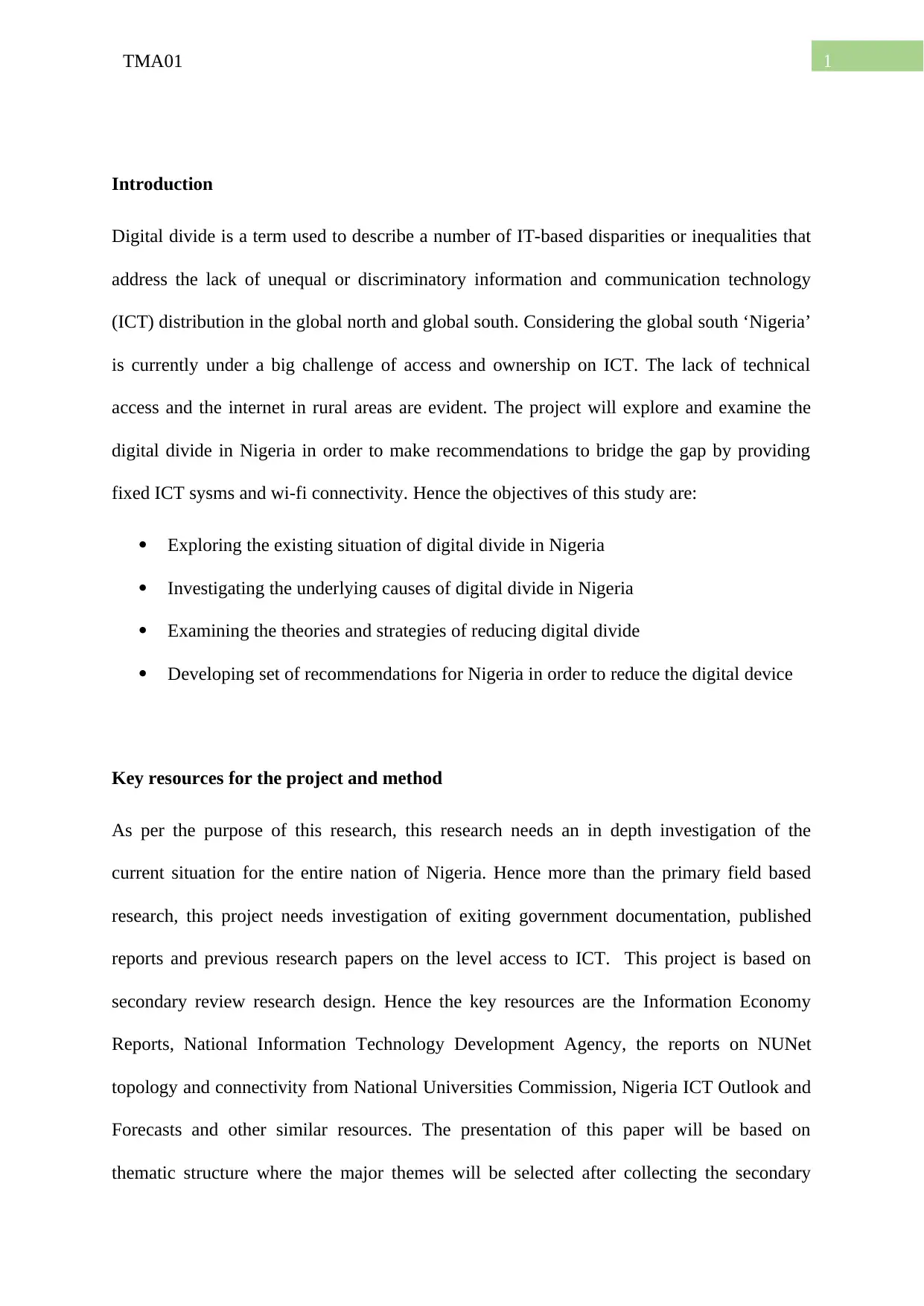
1TMA01
Introduction
Digital divide is a term used to describe a number of IT-based disparities or inequalities that
address the lack of unequal or discriminatory information and communication technology
(ICT) distribution in the global north and global south. Considering the global south ‘Nigeria’
is currently under a big challenge of access and ownership on ICT. The lack of technical
access and the internet in rural areas are evident. The project will explore and examine the
digital divide in Nigeria in order to make recommendations to bridge the gap by providing
fixed ICT sysms and wi-fi connectivity. Hence the objectives of this study are:
Exploring the existing situation of digital divide in Nigeria
Investigating the underlying causes of digital divide in Nigeria
Examining the theories and strategies of reducing digital divide
Developing set of recommendations for Nigeria in order to reduce the digital device
Key resources for the project and method
As per the purpose of this research, this research needs an in depth investigation of the
current situation for the entire nation of Nigeria. Hence more than the primary field based
research, this project needs investigation of exiting government documentation, published
reports and previous research papers on the level access to ICT. This project is based on
secondary review research design. Hence the key resources are the Information Economy
Reports, National Information Technology Development Agency, the reports on NUNet
topology and connectivity from National Universities Commission, Nigeria ICT Outlook and
Forecasts and other similar resources. The presentation of this paper will be based on
thematic structure where the major themes will be selected after collecting the secondary
Introduction
Digital divide is a term used to describe a number of IT-based disparities or inequalities that
address the lack of unequal or discriminatory information and communication technology
(ICT) distribution in the global north and global south. Considering the global south ‘Nigeria’
is currently under a big challenge of access and ownership on ICT. The lack of technical
access and the internet in rural areas are evident. The project will explore and examine the
digital divide in Nigeria in order to make recommendations to bridge the gap by providing
fixed ICT sysms and wi-fi connectivity. Hence the objectives of this study are:
Exploring the existing situation of digital divide in Nigeria
Investigating the underlying causes of digital divide in Nigeria
Examining the theories and strategies of reducing digital divide
Developing set of recommendations for Nigeria in order to reduce the digital device
Key resources for the project and method
As per the purpose of this research, this research needs an in depth investigation of the
current situation for the entire nation of Nigeria. Hence more than the primary field based
research, this project needs investigation of exiting government documentation, published
reports and previous research papers on the level access to ICT. This project is based on
secondary review research design. Hence the key resources are the Information Economy
Reports, National Information Technology Development Agency, the reports on NUNet
topology and connectivity from National Universities Commission, Nigeria ICT Outlook and
Forecasts and other similar resources. The presentation of this paper will be based on
thematic structure where the major themes will be selected after collecting the secondary
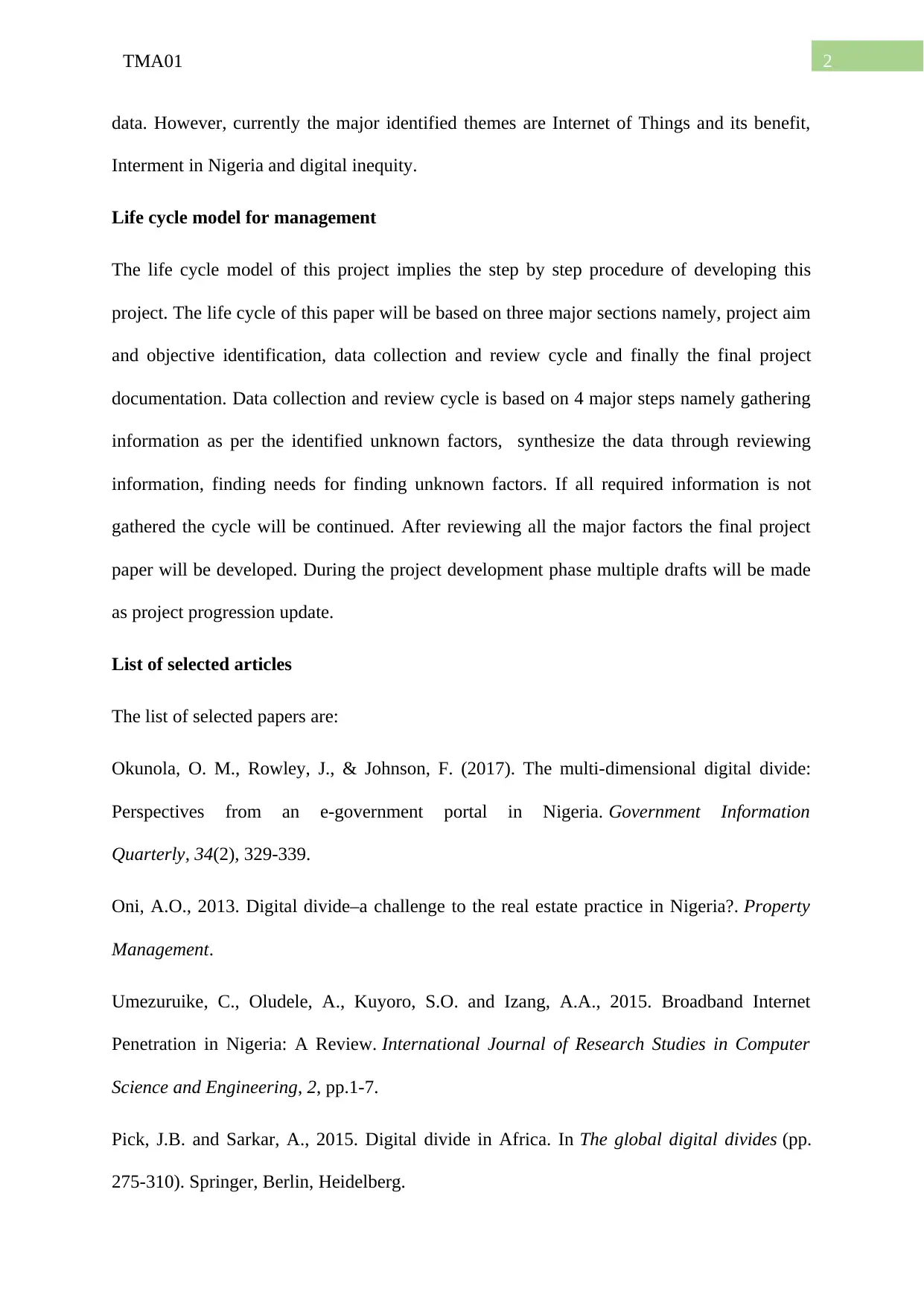
2TMA01
data. However, currently the major identified themes are Internet of Things and its benefit,
Interment in Nigeria and digital inequity.
Life cycle model for management
The life cycle model of this project implies the step by step procedure of developing this
project. The life cycle of this paper will be based on three major sections namely, project aim
and objective identification, data collection and review cycle and finally the final project
documentation. Data collection and review cycle is based on 4 major steps namely gathering
information as per the identified unknown factors, synthesize the data through reviewing
information, finding needs for finding unknown factors. If all required information is not
gathered the cycle will be continued. After reviewing all the major factors the final project
paper will be developed. During the project development phase multiple drafts will be made
as project progression update.
List of selected articles
The list of selected papers are:
Okunola, O. M., Rowley, J., & Johnson, F. (2017). The multi-dimensional digital divide:
Perspectives from an e-government portal in Nigeria. Government Information
Quarterly, 34(2), 329-339.
Oni, A.O., 2013. Digital divide–a challenge to the real estate practice in Nigeria?. Property
Management.
Umezuruike, C., Oludele, A., Kuyoro, S.O. and Izang, A.A., 2015. Broadband Internet
Penetration in Nigeria: A Review. International Journal of Research Studies in Computer
Science and Engineering, 2, pp.1-7.
Pick, J.B. and Sarkar, A., 2015. Digital divide in Africa. In The global digital divides (pp.
275-310). Springer, Berlin, Heidelberg.
data. However, currently the major identified themes are Internet of Things and its benefit,
Interment in Nigeria and digital inequity.
Life cycle model for management
The life cycle model of this project implies the step by step procedure of developing this
project. The life cycle of this paper will be based on three major sections namely, project aim
and objective identification, data collection and review cycle and finally the final project
documentation. Data collection and review cycle is based on 4 major steps namely gathering
information as per the identified unknown factors, synthesize the data through reviewing
information, finding needs for finding unknown factors. If all required information is not
gathered the cycle will be continued. After reviewing all the major factors the final project
paper will be developed. During the project development phase multiple drafts will be made
as project progression update.
List of selected articles
The list of selected papers are:
Okunola, O. M., Rowley, J., & Johnson, F. (2017). The multi-dimensional digital divide:
Perspectives from an e-government portal in Nigeria. Government Information
Quarterly, 34(2), 329-339.
Oni, A.O., 2013. Digital divide–a challenge to the real estate practice in Nigeria?. Property
Management.
Umezuruike, C., Oludele, A., Kuyoro, S.O. and Izang, A.A., 2015. Broadband Internet
Penetration in Nigeria: A Review. International Journal of Research Studies in Computer
Science and Engineering, 2, pp.1-7.
Pick, J.B. and Sarkar, A., 2015. Digital divide in Africa. In The global digital divides (pp.
275-310). Springer, Berlin, Heidelberg.
⊘ This is a preview!⊘
Do you want full access?
Subscribe today to unlock all pages.

Trusted by 1+ million students worldwide
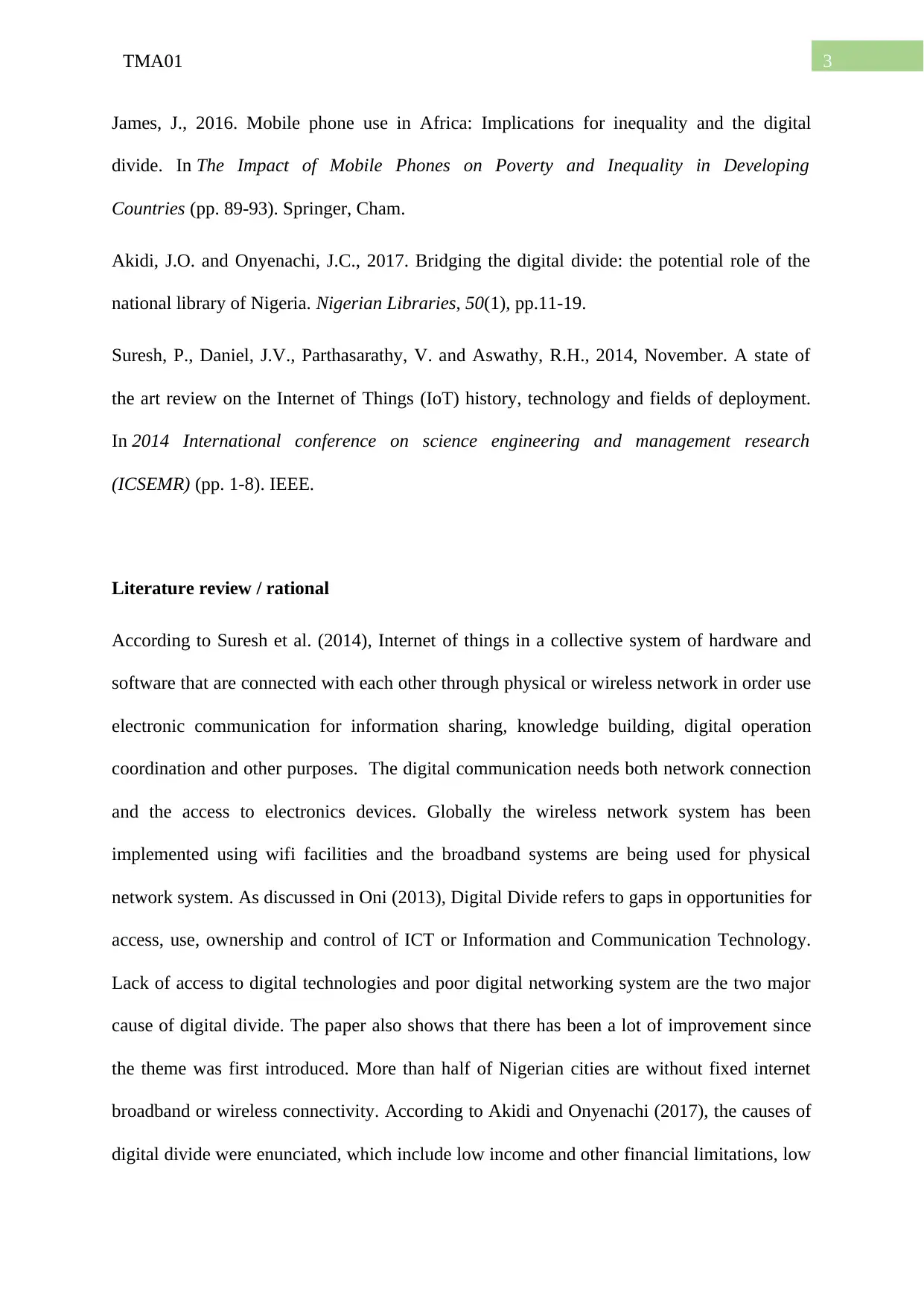
3TMA01
James, J., 2016. Mobile phone use in Africa: Implications for inequality and the digital
divide. In The Impact of Mobile Phones on Poverty and Inequality in Developing
Countries (pp. 89-93). Springer, Cham.
Akidi, J.O. and Onyenachi, J.C., 2017. Bridging the digital divide: the potential role of the
national library of Nigeria. Nigerian Libraries, 50(1), pp.11-19.
Suresh, P., Daniel, J.V., Parthasarathy, V. and Aswathy, R.H., 2014, November. A state of
the art review on the Internet of Things (IoT) history, technology and fields of deployment.
In 2014 International conference on science engineering and management research
(ICSEMR) (pp. 1-8). IEEE.
Literature review / rational
According to Suresh et al. (2014), Internet of things in a collective system of hardware and
software that are connected with each other through physical or wireless network in order use
electronic communication for information sharing, knowledge building, digital operation
coordination and other purposes. The digital communication needs both network connection
and the access to electronics devices. Globally the wireless network system has been
implemented using wifi facilities and the broadband systems are being used for physical
network system. As discussed in Oni (2013), Digital Divide refers to gaps in opportunities for
access, use, ownership and control of ICT or Information and Communication Technology.
Lack of access to digital technologies and poor digital networking system are the two major
cause of digital divide. The paper also shows that there has been a lot of improvement since
the theme was first introduced. More than half of Nigerian cities are without fixed internet
broadband or wireless connectivity. According to Akidi and Onyenachi (2017), the causes of
digital divide were enunciated, which include low income and other financial limitations, low
James, J., 2016. Mobile phone use in Africa: Implications for inequality and the digital
divide. In The Impact of Mobile Phones on Poverty and Inequality in Developing
Countries (pp. 89-93). Springer, Cham.
Akidi, J.O. and Onyenachi, J.C., 2017. Bridging the digital divide: the potential role of the
national library of Nigeria. Nigerian Libraries, 50(1), pp.11-19.
Suresh, P., Daniel, J.V., Parthasarathy, V. and Aswathy, R.H., 2014, November. A state of
the art review on the Internet of Things (IoT) history, technology and fields of deployment.
In 2014 International conference on science engineering and management research
(ICSEMR) (pp. 1-8). IEEE.
Literature review / rational
According to Suresh et al. (2014), Internet of things in a collective system of hardware and
software that are connected with each other through physical or wireless network in order use
electronic communication for information sharing, knowledge building, digital operation
coordination and other purposes. The digital communication needs both network connection
and the access to electronics devices. Globally the wireless network system has been
implemented using wifi facilities and the broadband systems are being used for physical
network system. As discussed in Oni (2013), Digital Divide refers to gaps in opportunities for
access, use, ownership and control of ICT or Information and Communication Technology.
Lack of access to digital technologies and poor digital networking system are the two major
cause of digital divide. The paper also shows that there has been a lot of improvement since
the theme was first introduced. More than half of Nigerian cities are without fixed internet
broadband or wireless connectivity. According to Akidi and Onyenachi (2017), the causes of
digital divide were enunciated, which include low income and other financial limitations, low
Paraphrase This Document
Need a fresh take? Get an instant paraphrase of this document with our AI Paraphraser
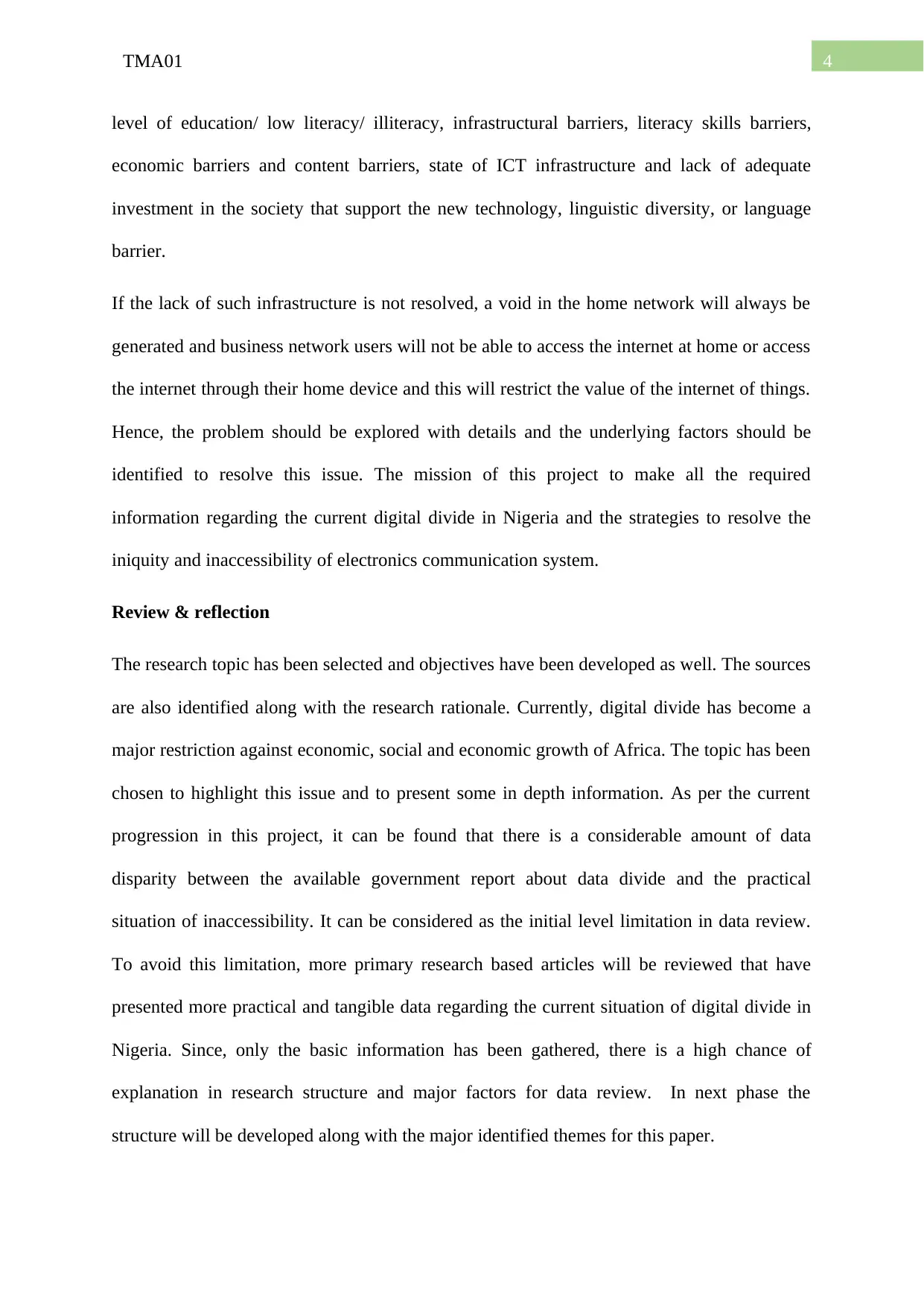
4TMA01
level of education/ low literacy/ illiteracy, infrastructural barriers, literacy skills barriers,
economic barriers and content barriers, state of ICT infrastructure and lack of adequate
investment in the society that support the new technology, linguistic diversity, or language
barrier.
If the lack of such infrastructure is not resolved, a void in the home network will always be
generated and business network users will not be able to access the internet at home or access
the internet through their home device and this will restrict the value of the internet of things.
Hence, the problem should be explored with details and the underlying factors should be
identified to resolve this issue. The mission of this project to make all the required
information regarding the current digital divide in Nigeria and the strategies to resolve the
iniquity and inaccessibility of electronics communication system.
Review & reflection
The research topic has been selected and objectives have been developed as well. The sources
are also identified along with the research rationale. Currently, digital divide has become a
major restriction against economic, social and economic growth of Africa. The topic has been
chosen to highlight this issue and to present some in depth information. As per the current
progression in this project, it can be found that there is a considerable amount of data
disparity between the available government report about data divide and the practical
situation of inaccessibility. It can be considered as the initial level limitation in data review.
To avoid this limitation, more primary research based articles will be reviewed that have
presented more practical and tangible data regarding the current situation of digital divide in
Nigeria. Since, only the basic information has been gathered, there is a high chance of
explanation in research structure and major factors for data review. In next phase the
structure will be developed along with the major identified themes for this paper.
level of education/ low literacy/ illiteracy, infrastructural barriers, literacy skills barriers,
economic barriers and content barriers, state of ICT infrastructure and lack of adequate
investment in the society that support the new technology, linguistic diversity, or language
barrier.
If the lack of such infrastructure is not resolved, a void in the home network will always be
generated and business network users will not be able to access the internet at home or access
the internet through their home device and this will restrict the value of the internet of things.
Hence, the problem should be explored with details and the underlying factors should be
identified to resolve this issue. The mission of this project to make all the required
information regarding the current digital divide in Nigeria and the strategies to resolve the
iniquity and inaccessibility of electronics communication system.
Review & reflection
The research topic has been selected and objectives have been developed as well. The sources
are also identified along with the research rationale. Currently, digital divide has become a
major restriction against economic, social and economic growth of Africa. The topic has been
chosen to highlight this issue and to present some in depth information. As per the current
progression in this project, it can be found that there is a considerable amount of data
disparity between the available government report about data divide and the practical
situation of inaccessibility. It can be considered as the initial level limitation in data review.
To avoid this limitation, more primary research based articles will be reviewed that have
presented more practical and tangible data regarding the current situation of digital divide in
Nigeria. Since, only the basic information has been gathered, there is a high chance of
explanation in research structure and major factors for data review. In next phase the
structure will be developed along with the major identified themes for this paper.
1 out of 5
Related Documents
Your All-in-One AI-Powered Toolkit for Academic Success.
+13062052269
info@desklib.com
Available 24*7 on WhatsApp / Email
![[object Object]](/_next/static/media/star-bottom.7253800d.svg)
Unlock your academic potential
Copyright © 2020–2025 A2Z Services. All Rights Reserved. Developed and managed by ZUCOL.





